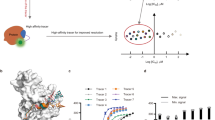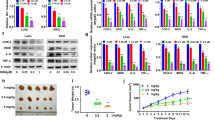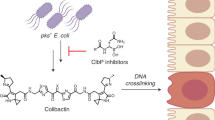Abstract
The binding of adenomatous polyposis coli (APC) to its receptor Asef relieves the negative intramolecular regulation of Asef and leads to aberrant cell migration in human colorectal cancer. Because of its crucial role in metastatic dissemination, the interaction between APC and Asef is an attractive target for anti-colorectal-cancer therapy. We rationally designed a series of peptidomimetics that act as potent inhibitors of the APC interface. Crystal structures and biochemical and cellular assays showed that the peptidomimetics in the APC pocket inhibited the migration of colorectal cells by disrupting APC–Asef interaction. By using the peptidomimetic inhibitor as a chemical probe, we found that CDC42 was the downstream GTPase involved in APC-stimulated Asef activation in colorectal cancer cells. Our work demonstrates the feasibility of exploiting APC–Asef interaction to regulate the migration of colorectal cancer cells, and provides what to our knowledge is the first class of protein–protein interaction inhibitors available for the development of cancer therapeutics targeting APC–Asef signaling.
This is a preview of subscription content, access via your institution
Access options
Access Nature and 54 other Nature Portfolio journals
Get Nature+, our best-value online-access subscription
$29.99 / 30 days
cancel any time
Subscribe to this journal
Receive 12 print issues and online access
$259.00 per year
only $21.58 per issue
Buy this article
- Purchase on Springer Link
- Instant access to full article PDF
Prices may be subject to local taxes which are calculated during checkout






Similar content being viewed by others
References
Bravo-Cordero, J.J., Hodgson, L. & Condeelis, J. Directed cell invasion and migration during metastasis. Curr. Opin. Cell Biol. 24, 277–283 (2012).
Eccles, S.A. & Welch, D.R. Metastasis: recent discoveries and novel treatment strategies. Lancet 369, 1742–1757 (2007).
Eccles, S.A. Targeting key steps in metastatic tumour progression. Curr. Opin. Genet. Dev. 15, 77–86 (2005).
Eccles, S.A., Box, C. & Court, W. Cell migration/invasion assays and their application in cancer drug discovery. Biotechnol. Annu. Rev. 11, 391–421 (2005).
Jones, D.H. et al. Regulation of cancer cell migration and bone metastasis by RANKL. Nature 440, 692–696 (2006).
Mitin, N. et al. Release of autoinhibition of ASEF by APC leads to CDC42 activation and tumor suppression. Nat. Struct. Mol. Biol. 14, 814–823 (2007).
Zhang, Z. et al. Structural basis for the recognition of Asef by adenomatous polyposis coli. Cell Res. 22, 372–386 (2012).
Kawasaki, Y., Sato, R. & Akiyama, T. Mutated APC and Asef are involved in the migration of colorectal tumour cells. Nat. Cell Biol. 5, 211–215 (2003).
Akiyama, T. & Kawasaki, Y. Wnt signalling and the actin cytoskeleton. Oncogene 25, 7538–7544 (2006).
Aoki, K. & Taketo, M.M. Adenomatous polyposis coli (APC): a multi-functional tumor suppressor gene. J. Cell Sci. 120, 3327–3335 (2007).
Schneikert, J. & Behrens, J. The canonical Wnt signalling pathway and its APC partner in colon cancer development. Gut 56, 417–425 (2007).
Kawasaki, Y. et al. Asef, a link between the tumor suppressor APC and G-protein signaling. Science 289, 1194–1197 (2000).
Kawasaki, Y. et al. Identification and characterization of Asef2, a guanine-nucleotide exchange factor specific for Rac1 and Cdc42. Oncogene 26, 7620–267 (2007).
Kawasaki, Y. et al. The adenomatous polyposis coli-associated guanine nucleotide exchange factor Asef is involved in angiogenesis. J. Biol. Chem. 285, 1199–1207 (2010).
Lo, M.C. et al. Evaluation of fluorescence-based thermal shift assays for hit identification in drug discovery. Anal. Biochem. 332, 153–159 (2004).
Pantoliano, M.W. et al. High-density miniaturized thermal shift assays as a general strategy for drug discovery. J. Biomol. Screen. 6, 429–440 (2001).
Niesen, F.H., Berglund, H. & Vedadi, M. The use of differential scanning fluorimetry to detect ligand interactions that promote protein stability. Nat. Protoc. 2, 2212–2221 (2007).
Vedadi, M. et al. Chemical screening methods to identify ligands that promote protein stability, protein crystallization, and structure determination. Proc. Natl. Acad. Sci. USA 103, 15835–15840 (2006).
Futaki, S. Membrane-permeable arginine-rich peptides and the translocation mechanisms. Adv. Drug Deliv. Rev. 57, 547–558 (2005).
Futaki, S. et al. Arginine-rich peptides. An abundant source of membrane-permeable peptides having potential as carriers for intracellular protein delivery. J. Biol. Chem. 276, 5836–5840 (2001).
Qvit, N., Rubin, S.J., Urban, T.J., Mochly-Rosen, D. & Gross, E.R. Peptidomimetic therapeutics: scientific approaches and opportunities. Drug Discov. Today 22, 454–462 (2017).
Richard, J.P. et al. Cell-penetrating peptides. A reevaluation of the mechanism of cellular uptake. J. Biol. Chem. 278, 585–590 (2003).
Martinez Molina, D. & Nordlund, P. The cellular thermal shift assay: a novel biophysical assay for in situ drug target engagement and mechanistic biomarker studies. Annu. Rev. Pharmacol. Toxicol. 56, 141–161 (2016).
Tan, B.X. et al. Assessing the efficacy of Mdm2/Mdm4-inhibiting stapled peptides using cellular thermal shift assays. Sci. Rep. 5, 12116 (2015).
Martinez Molina, D. et al. Monitoring drug target engagement in cells and tissues using the cellular thermal shift assay. Science 341, 84–87 (2013).
Almqvist, H. et al. CETSA screening identifies known and novel thymidylate synthase inhibitors and slow intracellular activation of 5-fluorouracil. Nat. Commun. 7, 11040 (2016).
Morishita, E.C. et al. Crystal structures of the armadillo repeat domain of adenomatous polyposis coli and its complex with the tyrosine-rich domain of Sam68. Structure 19, 1496–1508 (2011).
Breitman, M., Zilberberg, A., Caspi, M. & Rosin-Arbesfeld, R. The armadillo repeat domain of the APC tumor suppressor protein interacts with Striatin family members. Biochim. Biophys. Acta 1783, 1792–1802 (2008).
Diemert, S. et al. Impedance measurement for real time detection of neuronal cell death. J. Neurosci. Methods 203, 69–77 (2012).
Kawasaki, Y. et al. The adenomatous polyposis coli-associated exchange factors Asef and Asef2 are required for adenoma formation in Apc(Min/+)mice. EMBO Rep. 10, 1355–1362 (2009).
Hamann, M.J., Lubking, C.M., Luchini, D.N. & Billadeau, D.D. Asef2 functions as a Cdc42 exchange factor and is stimulated by the release of an autoinhibitory module from a concealed C-terminal activation element. Mol. Cell. Biol. 27, 1380–1393 (2007).
Montorsi, L. et al. Loss of ZFP36 expression in colorectal cancer correlates to wnt/β-catenin activity and enhances epithelial-to-mesenchymal transition through upregulation of ZEB1, SOX9 and MACC1. Oncotarget 7, 59144–59157 (2016).
Du, W.Y. et al. The loss-of-function mutations and down-regulated expression of ASB3 gene promote the growth and metastasis of colorectal cancer cells. Chin. J. Cancer 36, 11 (2017).
Ding, K.F. et al. Effect of SNC19/ST14 gene overexpression on invasion of colorectal cancer cells. World J. Gastroenterol. 11, 5651–5654 (2005).
Sbai, O. et al. RAGE-TXNIP axis is required for S100B-promoted Schwann cell migration, fibronectin expression and cytokine secretion. J. Cell Sci. 123, 4332–4339 (2010).
van Es, J.H., Giles, R.H. & Clevers, H.C. The many faces of the tumor suppressor gene APC. Exp. Cell Res. 264, 126–134 (2001).
Farrington, S.M. & Dunlop, M.G. Mosaicism and sporadic familial adenomatous polyposis. Am. J. Hum. Genet. 64, 653–658 (1999).
Ripka, A.S. & Rich, D.H. Peptidomimetic design. Curr. Opin. Chem. Biol. 2, 441–452 (1998).
Pelay-Gimeno, M., Glas, A., Koch, O. & Grossmann, T.N. Structure-based design of inhibitors of protein-protein interactions: mimicking peptide binding epitopes. Angew. Chem. Int. Edn. Engl. 54, 8896–8927 (2015).
Stone, T.A. & Deber, C.M. Therapeutic design of peptide modulators of protein-protein interactions in membranes. Biochim. Biophys. Acta 1859, 577–585 (2017).
Fosgerau, K. & Hoffmann, T. Peptide therapeutics: current status and future directions. Drug Discov. Today 20, 122–128 (2015).
Milligan, R.A. Protein-protein interactions in the rigor actomyosin complex. Proc. Natl. Acad. Sci. USA 93, 21–26 (1996).
Sakurai, K., Schubert, C. & Kahne, D. Crystallographic analysis of an 8-mer p53 peptide analogue complexed with MDM2. J. Am. Chem. Soc. 128, 11000–11001 (2006).
Johnson, D.K. & Karanicolas, J. Selectivity by small-molecule inhibitors of protein interactions can be driven by protein surface fluctuations. PLoS Comput. Biol. 11, e1004081 (2015).
Kaspar, A.A. & Reichert, J.M. Future directions for peptide therapeutics development. Drug Discov. Today 18, 807–817 (2013).
Florén, A., Mäger, I. & Langel, U. Uptake kinetics of cell-penetrating peptides. Methods Mol. Biol. 683, 117–128 (2011).
Nikolovska-Coleska, Z. et al. Development and optimization of a binding assay for the XIAP BIR3 domain using fluorescence polarization. Anal. Biochem. 332, 261–273 (2004).
Chen, C. et al. SUMOylation of TARBP2 regulates miRNA/siRNA efficiency. Nat. Commun. 6, 8899 (2015).
Yu, J. et al. RhoGDI SUMOylation at Lys-138 increases its binding activity to Rho GTPase and its inhibiting cancer cell motility. J. Biol. Chem. 287, 13752–13760 (2012).
Zhao, X. et al. miR186 suppresses prostate cancer progression by targeting Twist1. Oncotarget 7, 33136–33151 (2016).
Liu, X. et al. MiRNA-296-3p-ICAM-1 axis promotes metastasis of prostate cancer by possible enhancing survival of natural killer cell-resistant circulating tumour cells. Cell Death Dis. 4, e928 (2013).
Anders, S. & Huber, W. Differential expression analysis for sequence count data. Genome Biol. 11, R106 (2010).
Acknowledgements
We sincerely thank T. Akiyama (University of Tokyo) for help with the cell migration assay and for fruitful discussions on application, S. Wang (University of Michigan) for design discussion and antibody shipping, and the Shanghai Synchrotron Radiation Facility (SSRF) for crystal diffraction. APC, Asef and full-length CDC42 were kind gifts from G. Wu (Shanghai Jiao-Tong University, Shanghai, China). This work was supported in part by the National Basic Research Program of China (973 Program) (grant 2015CB910403 to J.Z.), the National Natural Science Foundation of China (grants 81630075 to J.Y., 81322046 and 81473137 to J.Z., and 81302698 to S.L.), the Innovative Research Group of NSFC (J.Z., J.Y. and G.C.), the Shanghai Rising-Star Program (grant 13QA1402300 to J.Z.), the Shanghai Sailing Program (grant 17YF1410600 to X.Y.), the National Program for Support of Top-notch Young Professionals (grant 2015 to J.Z.), and the Program for New Century Excellent Talents in University (grant NCET-12-0355 to J.Z.).
Author information
Authors and Affiliations
Contributions
J.Z. designed the research project. J.Z., H.J., R.D., X.Y., J.S., S.L., X.L., G.C., and J.Y. performed the biological experiments and analyzed data. Y.Z. and K.S. performed the crystallography. X.Y. carried out peptide synthesis, purification and characterization. Y.C., Y.E.C., Q.Z., G.W., and J.L. generated key protein reagents. K.S. solved the crystal structures. All authors contributed to the manuscript, with J.Z. and J.Y. assuming responsibility for the manuscript in its entirety.
Corresponding authors
Ethics declarations
Competing interests
The authors declare no competing financial interests.
Supplementary information
Supplementary Text and Figures
Supplementary Results, Supplementary Tables 1–7 and Supplementary Figures 1–34. (PDF 5512 kb)
Rights and permissions
About this article
Cite this article
Jiang, H., Deng, R., Yang, X. et al. Peptidomimetic inhibitors of APC–Asef interaction block colorectal cancer migration. Nat Chem Biol 13, 994–1001 (2017). https://doi.org/10.1038/nchembio.2442
Received:
Accepted:
Published:
Issue Date:
DOI: https://doi.org/10.1038/nchembio.2442
This article is cited by
-
Rational design of a sensitivity-enhanced tracer for discovering efficient APC–Asef inhibitors
Nature Communications (2022)
-
A RAC-GEF network critical for early intestinal tumourigenesis
Nature Communications (2021)
-
Structure-based discovery of small molecule APC-Asef interaction inhibitors: In silico approaches and molecular dynamics simulations
Journal of Molecular Modeling (2020)
-
ALKBH5 Holds Prognostic Values and Inhibits the Metastasis of Colon Cancer
Pathology & Oncology Research (2020)
-
Autocrine motility factor promotes endometrial cancer progression by targeting GPER-1
Cell Communication and Signaling (2019)



